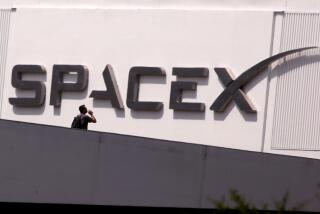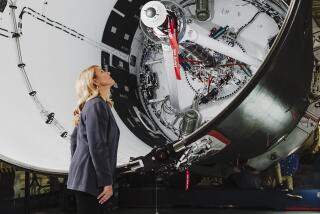Rocketdyne sold to GenCorp for $550 million
- Share via
Pratt & Whitney Rocketdyne, the pioneering rocket engine manufacturing business in the San Fernando Valley, has been sold by its parent company of seven years to Sacramento aerospace and technology firm GenCorp Inc. for $550 million.
The sale of Rocketdyne to GenCorp marks the combination of two iconic California rocket companies — and longtime competitors. GenCorp also owns Aerojet, the Sacramento aerospace firm founded in 1942.
The deal is the latest chapter of consolidation in the aerospace industry, which has unfolded over the last two decades and has cost tens of thousands of jobs throughout the Southland.
GenCorp’s chief executive said the transaction almost doubles the size of his company.
“We see great strategic value in this transaction for the country, our customers, partner supply base and our shareholders,” CEO Scott Seymour said in a statement. “The combined enterprise will be better positioned to compete in a dynamic, highly competitive marketplace and provide more affordable products for our customers.”
Rocketdyne is no stranger to being sold. The company was formed by North American Aviation after World War II, spurred by the success of the German V-2 missile. North American later merged with Rockwell International, which became part of Boeing. In 2005,United Technologies Corp. bought Rocketdyne and merged it with its Pratt & Whitney unit.
Rocketdyne builds rocket engines for NASA, military rockets and missiles at a sprawling 47-acre facility in Canoga Park. The company is perhaps best known as the maker of the space shuttles’ main rocket engines.
Rocketdyne said it had about $750 million in sales last year and has about 2,400 employees nationwide, mostly in California.
Since Rocketdyne’s inception, the U.S. space program has been at the core of its business.
Rocketdyne engineers were at the forefront of developing engines in the days of slide rules and drafting tables, before advanced computers took a central role. The company supplied the major engines for the colossal Saturn rocket that put man on the moon.
By 1965, there were about 17,700 people in California working for the company.
At the time, most rocket engines were one-of-a-kind chemistry sets — good for one flight only. But that changed in the early 1970s, when NASA began the space shuttle program. The agency wanted reusable engines to propel the 2,250-ton shuttle assembly as high as 384 miles above Earth.
The company tested its engines in the Santa Susana Mountains, which is now a cleanup site because of health risks associated with soil contaminated by years of rocket and nuclear testing.
The sale of Rocketdyne comes a year after NASA ended its 30-year space shuttle program. Rocketdyne developed, built and refurbished 56 reusable engines for the program in Canoga Park.
The storied site — once swarming with engineers and technicians toiling on various programs — is nearly empty compared with the boom times. The scores of massive machines once humming and churning out parts for spacecraft now sit dormant. Much of the workforce has been moved to a larger facility a few miles away on DeSoto Avenue.
The Rocketdyne sale has been in the offing since March, when parent company United Technologies announced that it needed funds to help finance last year’s $16.5-billion purchase of aerospace supplier Goodrich Corp.
GenCorp. said the Rocketdyne purchase price, which is subject to adjustment, is expected to be financed with a combination of cash on hand and issuance of debt. The acquisition still has to clear regulatory approvals before being finalized. The sale is slated to close in the first half of 2013.
Mike Blades, an aerospace analyst with the research firm Frost & Sullivan, said Rocketdyne’s price seemed “light” to him. It was expected to fetch about $1 billion, he said.
He also noted that GenCorp is worth about $450 million based on its stock price.
“The company is worth less than what it’s paying to acquire Rocketdyne — that’s not very common,” Blades said. “There would be jobs at risk anyway, but there are a lot more jobs at risk because of the way this thing is set up.”
Rocketdyne and GenCorp would not comment beyond prepared statements, which made no mention of jobs.
In the early days of rocketry, a bitter rivalry played out among Aerojet, Pratt & Whitney and Rocketdyne for lucrative U.S. government work. Now the rocket engine makers will compete as one entity in a shifting space industry. NASA and telecommunications companies are increasingly looking to commercial space companies such asSpace Exploration Technologies Corp., or SpaceX, in Hawthorne.
On its own, SpaceX builds its Dragon capsule and the Falcon 9 rocket that lifted the Dragon into orbit. By contrast, the overall design of NASA’s previous space-going vehicles and their missions were tightly controlled by the government and contracted to aerospace giants like Rocketdyne.
Rocketdyne received good news in September when NASA unveiled its plan to build a heavy launch vehicle capable of sending astronauts beyond low-Earth orbit by 2025. The engine manufacturer will supply both the first- and second-stage liquid hydrogen rockets. But NASA has not provided specific goals or timelines for such missions.
Rocketdyne also still builds engines for Air Force rockets that lift military satellites into orbit.
More to Read
Inside the business of entertainment
The Wide Shot brings you news, analysis and insights on everything from streaming wars to production — and what it all means for the future.
You may occasionally receive promotional content from the Los Angeles Times.











